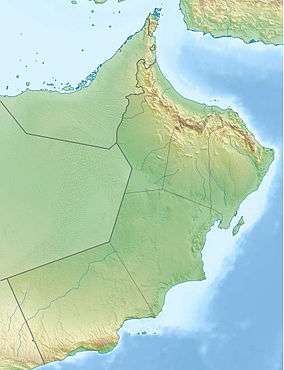Jebel Akhdar (Oman)
The Jebel Akhdar or Al Jabal Al Akhdar (Arabic: ٱلْجَبَل ٱلْأَخْضَر, romanized: Al-Jabal Al-Akhḍar, lit. 'The Green Mountain'), is part of Al Hajar Mountains range in Ad Dakhiliyah Governorate of Oman. It rises to a height of 2,980 m (9,780 ft) [1] and encompasses the Saiq Plateau at 2,000 m above sea level. Jebel Akhdar is famous for its labyrinth of wadis and terraced orchards, where pomegranates, apricots and roses grow in abundance due to its mild Mediterranean climate.
| Jebel Akhdar | |
|---|---|
 Terraces in Jebel Akhdar, 2011 | |
| Highest point | |
| Elevation | 2,980 m (9,780 ft) |
| Coordinates | |
| Naming | |
| Native name | ٱلْجَبَل ٱلْأَخْضَر (Arabic) |
| Geography | |
 Jebel Akhdar Oman | |
| Location | |
| Parent range | Al Hajar Mountains |
Description
This mostly limestone[2] mountain is one of the highest points in Oman and eastern Arabia. Jebel Akhdar lies at the central section of Al Hajar range, located around 150 km (93 mi) from Muscat and accessible only by four-wheel drive.[3] The range is mostly desert, but at higher altitudes receives around 300 mm (12 in) of precipitation annually — moist enough to allow the growth of shrubs and trees and support agriculture.[4] It is this that gives the mountains their "green" name.[5][6]
An old stronghold on the inland side of the mountain is Birkat al-Mawz, or Pool of the Plantains, with a layout similar to the nearby Jabrin palace[7]
Poised across the yawning mouth of a great pass into the mountains, Birkat al-Mawz was one of the fortresses of the Bani Riyam tribe which controlled the mountain heartland. Collapsing into ruin until recently, the mud-brick fortress and its painted ceilings are now well on the way to restoration."
— Aramco World.
The area is about a 45-minute drive from Nizwa and is known for its traditional rose water extraction[8][9] and agricultural products including pomegranates, walnuts, apricots, black grapes and peaches. It is also the site of honey bee breeding for much of Oman.[10] Agricultural production is improved by the use of Falaj irrigation channels and their associated terraces system devised by the local farmers, who have lived on this mountain for hundreds of years. Al Sogara is a historic village carved into the mountainside.[11] The Jebel is mostly inhabited by the ancient Arab tribe Bani Riyam (al Riyamy).[12] Most descendants of the tribe are now in the four nearby villages, including Nizwa, Izki and Ibra.[13]
History
Between 1954 and 1959, the area became a site of the Jebel Akhdar War, a conflict between Omani forces loyal to the sultan of Oman (aided by British soldiers, including the Special Air Service) and Saudi Arabian-backed rebel forces of the inland Imamate of Oman.[14]
In August 2011, Sultan Qaboos designated Jebel Akhdar a nature reserve in a bid to conserve its unique yet fragile biodiversity. A decree issued by Sultan Qaboos established the 'Jebel Akhdar Sanctuary for Natural Sceneries.' The Minister of Environment and Climate Affairs has authority to draft guidelines regulating access and developmental activity within the reserve.[15]
Since 2011, the mountain has featured as the principal climb in the Tour of Oman road bicycle race.[16] In the area, several important rock art sites, with figures dating back to 6000 years ago, have been discovered and studied.[17]
See also
References
- "Mountains in Oman". Ministry of Tourism, Sultanate of Oman.
- "'Persian Gulf. Handbooks prepared under the direction of the Historical Section of the Foreign Office - no 81' [7] (13/94)". Qatar Digital Library. 2014-08-21. Retrieved 2016-07-09.
- "Al Jabal Al Akhdar (Green Mountain)". Ministry of Tourism, Sultanate of Oman.
- "Al Jabal Al Akhdar". www.nizwa.net. Archived from the original on 2016-03-19. Retrieved 2016-07-09.
- Andrea Schulte-Peevers; Iain Shearer. Oman. Lonely Planet. p. 222.
- "Great outings for the summer months: Jebel Shams in Oman". OutdoorUAE. 2012-06-12. Archived from the original on 2016-08-16. Retrieved 2016-07-09.
- "Saudi Aramco World: Fortified Oman". archive.aramcoworld.com. Retrieved 2016-07-09.
- Newspaper, Muscat Daily. "Rosewater distillation, profession of generations in Jebel Akhdar". Muscat Daily News. Retrieved 2016-07-09.
- "Oman's rose water: A history of tradition". 2010-12-08. Retrieved 2016-07-09.
- "Fruits of the Jabal". www.nizwa.net. Archived from the original on 2015-10-24. Retrieved 2016-07-09.
- "GIAHS - Globally Important Agricultural Heritage Systems: Al Jabal Al Akhdar Aflaj and Terraced Fields System, OMAN". www.fao.org. Retrieved 2016-07-09.
- "'Gazetteer of Arabia Vol. II' [1576] (655/688)". Qatar Digital Library. 2014-10-22. Retrieved 2016-07-09.
- Searle, Pauline (2016-04-14). Dawn Over Oman. Routledge. pp. with Figure No. 23. ISBN 9781317242093.
- Pike, John. "The Jebel Akhdar War Oman 1954-1959". www.globalsecurity.org. Retrieved 2016-07-09.
- Report, Staff (2011-08-18). "Oman's 'Green Mountain' declared nature reserve". Retrieved 2016-07-09.
- Puddicombe, Stephen. "Tour of Oman 2015 preview". Cycling Weekly. Retrieved 14 February 2015.
- Fossati, Angelo Eugenio. "Rock Art in Jebel Akhdar, Sultanate of Oman, first overview and state of research, TRACCE Online Rock Art Bulletin". Retrieved 29 August 2015.
External links
| Wikimedia Commons has media related to Jebel Akhdar, Oman. |
.jpg)


